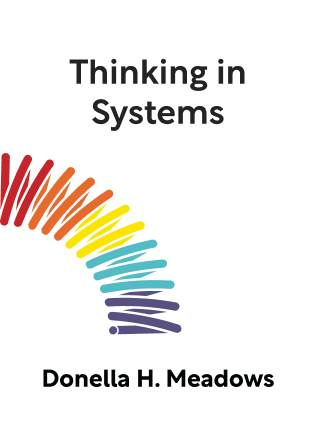

This article is an excerpt from the Shortform summary of "Thinking in Systems" by Donella H. Meadows. Shortform has the world's best summaries of books you should be reading.
Like this article? Sign up for a free trial here .
Do you want to know how to become a systems thinker? How is the systems thinker different than other types of thinkers.
The systems thinker is able to look at all things as the system. Many things in our lives already work as systems, but the systems thinker can apply to concepts of systems to other processes to help them work better.
Read more about becoming “the systems thinker” and how to improve your system thinking skills.
Becoming The Systems Thinker
Before you eagerly dive in and try to repair a system, make sure you understand it well first. This will help you learn how to become a systems thinker.
Stop and Watch
We all have our favorite assumptions about how things work, and how problems should be fixed. To truly understand a system, we have to discard these and start from scratch.
To understand a system, first watch to see how it behaves. Get a sense of its beat.
This doesn’t necessarily mean stopping and watching it in real-time. Rather:
- Research its history. How did this system get here?
- Get data. Chart important metrics over time, and tease out their relationships with each other
- Ask people in the system what’s happened (while being wary of accepting anyone’s beliefs too quickly)
- Ask questions. What’s working well in the system? What’s working poorly?
Appreciate the Unquantifiables
Our modern industrial society obsesses over things that are quantifiable. Find how to express things in numbers, then make the good numbers go up. (Shortform note: This is another paradigm we tend to accept without thinking about it.)
In your system model, don’t ignore the unquantifiables. These might drive actors in the system as strongly as the quantifiables, and omitting them will lead to an incomplete model. These unquantifiables might include things like:
- Human dignity
- Contentment in life
- Hope and inspiration
- National pride
If you want to build a quantitative system model, you may need to put your unquantifiable onto a quantitative scale (such as measuring human dignity on a scale of 1 to 10).
The Systems Thinker Expands Their Boundaries
As discussed earlier, we are prone to drawing artificially narrow boundaries when understanding systems. To really appreciate a system’s complexity and guide it to a good outcome, you’ll need to relentlessly expand the boundaries by which you perceive the world. The system thinker does the following:
Expand Your Boundaries of Time
As a society, we tend to fixate on the short-term. In how few years can this investment pay off? How do we get faster growth, sooner?
Systems, of course, can persist over decades, centuries, and much longer time scales. Focusing on the short-term is like hiking a treacherous path by staring down at your feet.
Instead, try thinking in centuries. How will this system behave 10 generations from now? System behavior 10 generations in the past affects your life today; system behavior today will affect lives 10 generations from now.
Expand Your Boundaries of Intellectual Disciplines
In order to learn how to become a systems thinker, and to make sense of a complex world, you’ll need to understand more disciplines beyond your major in college, your current profession, and what you’re comfortable with. You’ll need to seek wisdom in psychology, economics, biology, the arts, religion, and more.
As you learn from these other disciplines, be aware that its practitioners see the world through their own lenses and draw their own boundaries. As an interdisciplinary thinker, you will need to hurdle these boundaries.
Expand Your Boundaries of Caring
Push yourself to care about more than you naturally do. The system is a cohesive whole and requires its parts to function properly. Your liver wouldn’t succeed if your heart failed, and vice versa. Likewise, the rich wouldn’t succeed if the poor failed; your country wouldn’t succeed if its neighbor failed; the world wouldn’t succeed if its natural ecosystems failed.
Articulate Your Model, Get Feedback, and Improve
As you understand a system, put pen to paper and draw a system diagram. Put into place the system elements and show how they interconnect. Draw the feedback loops (both balancing and reinforcing), find the delays. Articulate the system’s goals and paradigms. The systems thinker does all these things.
Drawing your system diagram makes explicit your assumptions about the system and how it works.
Next, expose this model to other credible people and invite their feedback. They will question your assumptions and push you to improve your understanding. You will have to admit your mistakes, redraw your model, and this trains your mental flexibility.
You will get many contradictory ideas. Be able to hold these in your head at the same time, rather than fixating on your favorite one. Rule out ideas only until you have enough evidence to do so.
Understand the Limits of Understanding
The allure of systems thinking is to gain a superpower to predict the world and to control it. Believing this is a great mistake. The world is complex, and many parts of it elude understanding.
But you can still play a role. You can’t predict a system exactly, but you can guide it to a good direction. You can’t control a system, but you can influence its design and evolution. The systems thinker is able to achieve this.

———End of Preview———
Like what you just read? Read the rest of the world's best summary of Donella H. Meadows's "Thinking in Systems" at Shortform .
Here's what you'll find in our full Thinking in Systems summary :
- How the world, from bathtub faucets to fish populations, can be seen as simple systems
- The key system traps that hold back progress, such as escalating arms races and policy addiction
- Why seeing the world as systems can give you superpowers in work and life






